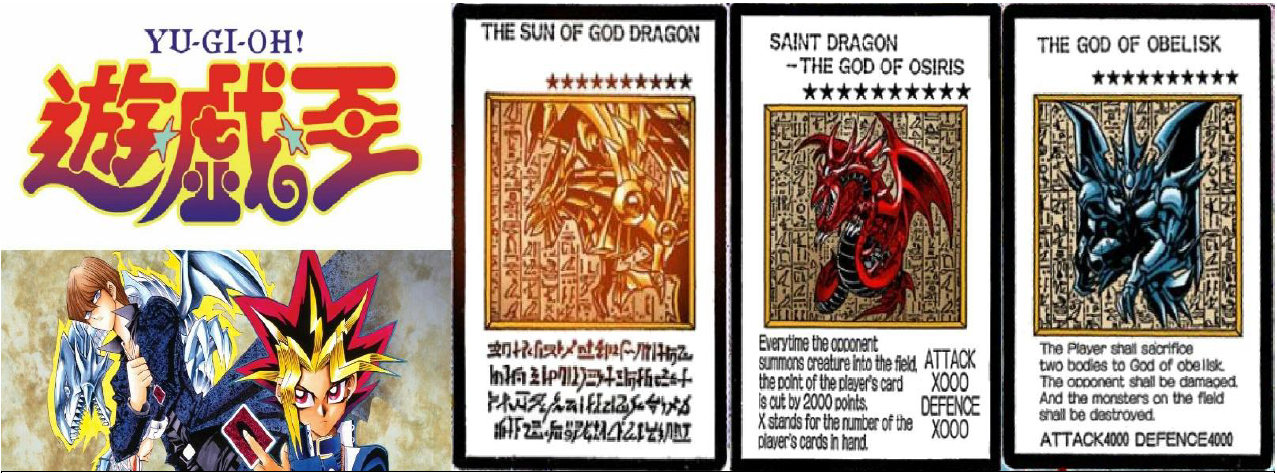 Top Left: Original Japanese Yu-Gi-Oh! Logo.
Top Left: Original Japanese Yu-Gi-Oh! Logo.Lower Left: Protagonist of the story Yugi Muto’s dark personality standing with his archrival, the iconic Seto Kaiba.
To the right side are the original designs of the iconic 3 Egyptian God cards from the Japanese manga.
Yu-Gi-Oh! Anime And Manga Breakdown: Shadow Games And The Millennium Puzzle
Note: The following article will stay as true to the original form of Yu-Gi-Oh! as possible, so the manga and Japanese anime names will be used instead of the English dubbed names. Here’s a key:
Jonouchi = Joey
Honda = Tristan
Anzu = Tea
Mai Kujaku = Mai Valentine
Sugoroku Mutou = Solomon Mutou
Ryoji = Duke
Tetsu Ushio = Tetsu Trudge
Introduction
Yu-Gi-Oh! has come a long way since the early stories about the possessed vigilante taking out crooks, moving on to a society that revolves around a children’s trading card game, all the way to the never expected future of Card Games On Motorcycles. Yes, Yu-Gi-Oh! Has surely come far, and while it sounds silly, and not a place one would want to reside in, it’s quite an interesting world to explore. So that’s what we’re going to do, starting with where the real story of Yu-Gi-Oh! began. But before that, it’s important to know some background knowledge on the structure of the story.
Yu-Gi-Oh! And It’s Variety of Entertainment Mediums
The original tale of the franchise started in 1996 in the form of a 38 volume manga. In 1998, the first Yu-Gi-Oh! Anime simply titled Yu-Gi-Oh! was produced by Toei Entertainment. It was 27 episodes, with one 30 minute special following it, and none of it was ever dubbed. Based on the first 7 volumes of the manga, it was hardly a faithful adaption, changing many of the games played, mixing up the order of events, changing the plot of events, and turning Miho Nosaka, a character featured in one chapter of the manga as the love interest of Honda into a main character who appeared in almost every episode of the show. Violence was also toned down from the manga, and deaths were changed to what you’d call a mental illnesses. From all of this, you could state that the Toei anime was the first Yu-Gi-Oh! anime to create another canonicity of the series.
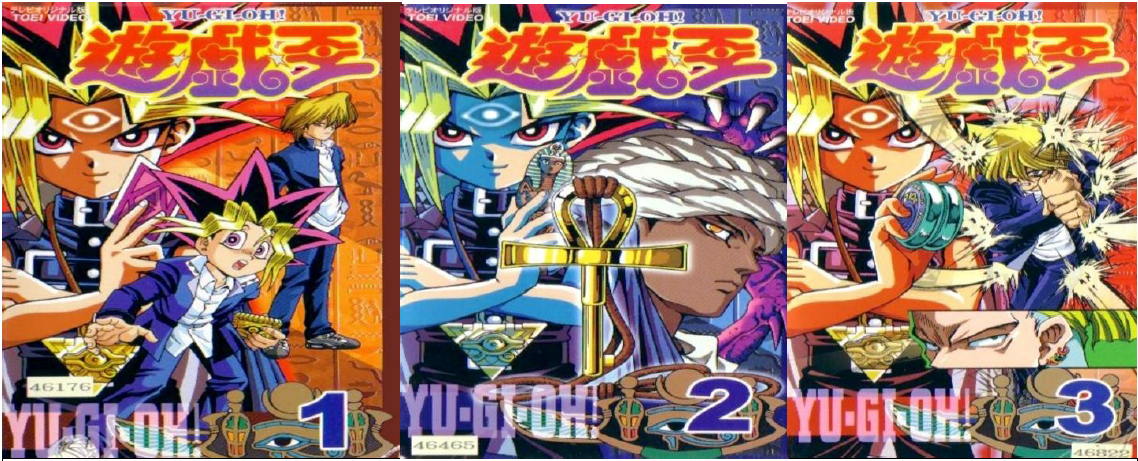 Cover of the first 3 VHS for the Toei anime.
Cover of the first 3 VHS for the Toei anime. Japanese Logo for the Yu-Gi-Oh! Duel Monsters anime.
Japanese Logo for the Yu-Gi-Oh! Duel Monsters anime.The second anime that was released, which fans are more familiar with, was called Yu-Gi-Oh! Duel Monsters! This anime, being over 200 episodes long is currently the longest running Yu-Gi-Oh! Series to have aired, and the first Yu-Gi-Oh! anime to come to the states. It restarted the series again, creating another canonicity, but many events from the first 7 manga volumes were skipped and the few that were adapted were out of order or mixed together. Also, just like the Toei anime it was not a very faithful adaption, changing the plot and toning down the violence in many instances. It’s arrival to the west was also in the form of a heavily localized dub by 4kids Entertainment. The following edits were made to efficiently localize the series for an American audience:
- The original Japanese soundtrack was replaced.
- Most violence, including fist fights have been removed.
- Every drop of blood has been removed.
- Japanese Logo for the Yu-Gi-Oh! Duel Monsters anime.
- Anything considerably emotional is removed, like a character being an orphan, or a friend turning on another friend.
- Dialogue is heavily edited, which includes removal of profanity. The dialogue is centered more on the card game and is much more light-hearted by adding puns and catch phrases, even at the cost of removing emotional or character developing lines.
- Death and references to death are removed. This includes making things up like the shadow realm to hide deaths, and taking out anything that could trigger an image of death such as a widespread light covering a city.
- Guns and weapons are removed, and a gun being held can be replaced with a pointing finger.
- Drugs are removed.
- Any form of sexual content is removed, to the extent skirts are made longer and cleavage is edited.
- In general, any piece of text is removed, regardless of what language it is.
- References to religious beliefs and religious symbols are generally removed, unless vital to the plot.
- Names are changed to suit an American audience.
- The setting is changed to America instead of Japan and frequent plot edits are done to support this.
- Consumerism is removed.
- The dubs of GX and 5ds have skipped numerous episodes and even entire seasons.
 Fingers are a lot more threatening then guns apparently.
Fingers are a lot more threatening then guns apparently.There was another English dub of the Duel Monsters! anime produced by Odex that was released in Southeast Asia. This dub used the 4kids names but was censored far less than the 4kids dub, even deciding to use the original Japanese soundtrack, but this dub was incomplete. It ran for only 90 episodes though. At one point, 4kids decided to make an uncut dub that would be distributed by Funimation Entertainment, unfortunately it was discontinued after the first 9 episodes. The normal 4kids names were used for most of the characters, but besides that this dub was completely uncut.
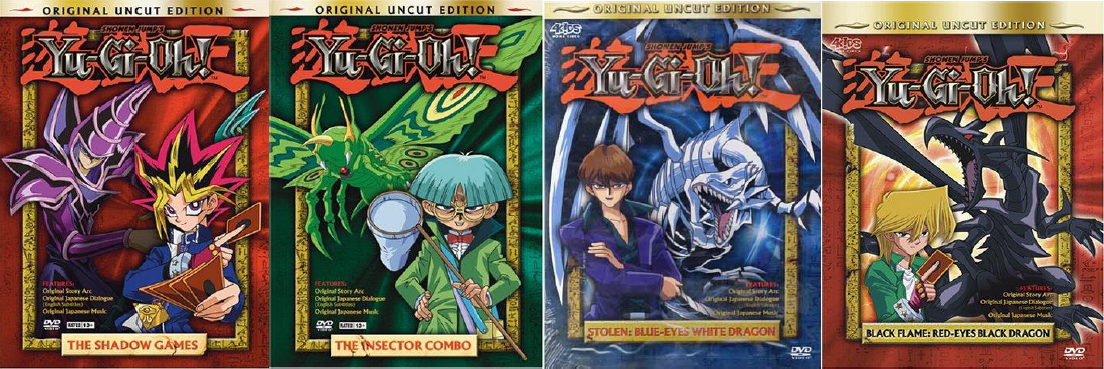 The only 3 dvd’s ever released for the uncut 4kids dub. There were 3 episodes on each, and the far right dvd was planned, even taking pre orders, but never released, leaving this dub at only 9 episodes.
The only 3 dvd’s ever released for the uncut 4kids dub. There were 3 episodes on each, and the far right dvd was planned, even taking pre orders, but never released, leaving this dub at only 9 episodes.The Puzzle Of The Gods
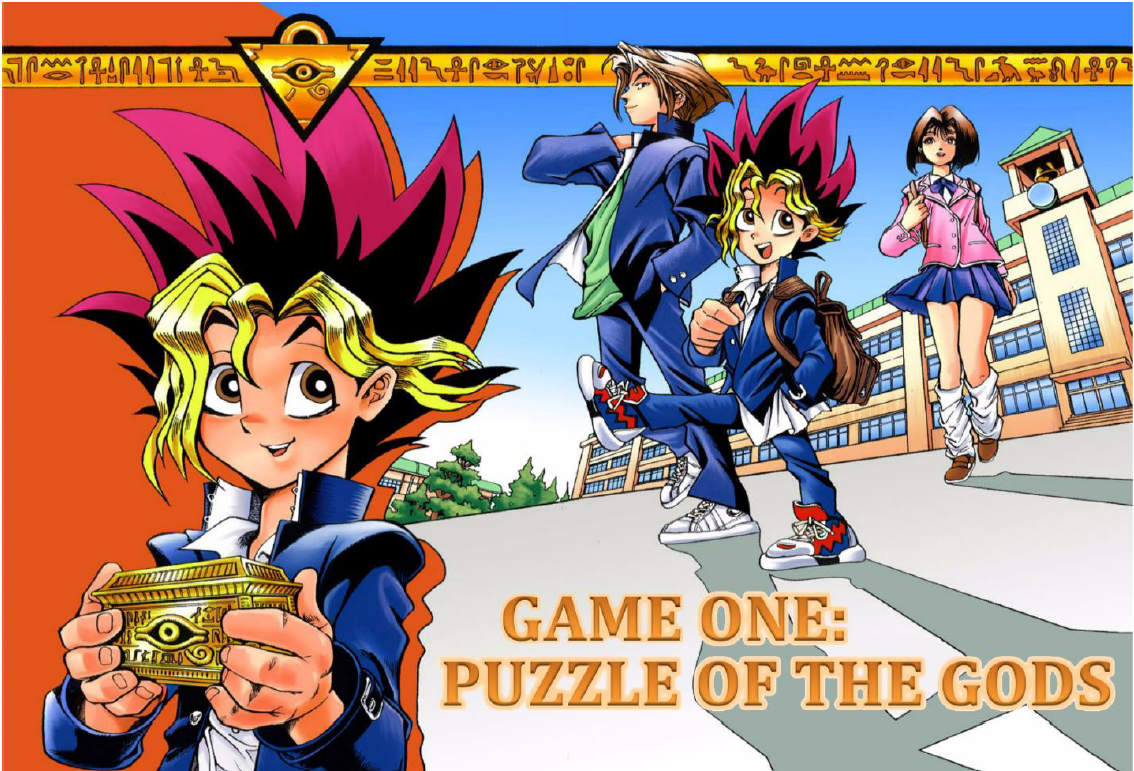 Digitally colored page from volume 1 of the manga.
Digitally colored page from volume 1 of the manga.That being said, it’s time to analyze the series. Throughout the first 7 volumes of the manga, which we’ll be analyzing first, very few things happen that’re vital to the plot because these volumes are comprised mostly by episodic plots. Because of that, we’ll only go in depth with the most relevant parts of these volumes. All in all that would have to be Yugi solving the millennium puzzle and inheriting it’s dark powers, the introduction of all the main characters, and the introduction to the plot dependent characters, Shadi, Kaiba, and Yami Bakura. Obviously we’ll start with the story that many have craved to know, how Yugi solved the millennium puzzle that possessed him with it’s evil and abusive power. So to start off, let’s look at a brief summary of our protagonist, Yugi Muto. He’s a wimpy high school student who loves to play games by himself even when asked to play with other people. At the start of the manga, he talks to himself about how he has something that’s very precious to him, a puzzle he’s been trying to solve for 8 years, and he pulls out the box that contains the pieces to the millennium puzzle. Immediately, his box is snatched out of his hand by Jonouchi and Honda, 2 kids who are intent on bullying Yugi so he can learn to be a man. At this point, the box is snatched from the hands of Jonouchi and Honda by a girl named Anzu, revealed to be Yugi’s only friend since elementary school. She scolds Jonouchi and Honda and causes them to run into the hall, where they express in their dialogue nothing but hate for Anzu. At this point, they’ve bumped into a very aggressive hall monitor named Ushio, and before Jonouchi tries yelling at him, Honda covers his mouth and explains how strict the man is. Jonouchi, right there and then throws a piece of the millennium puzzle that he’d stolen into the river.
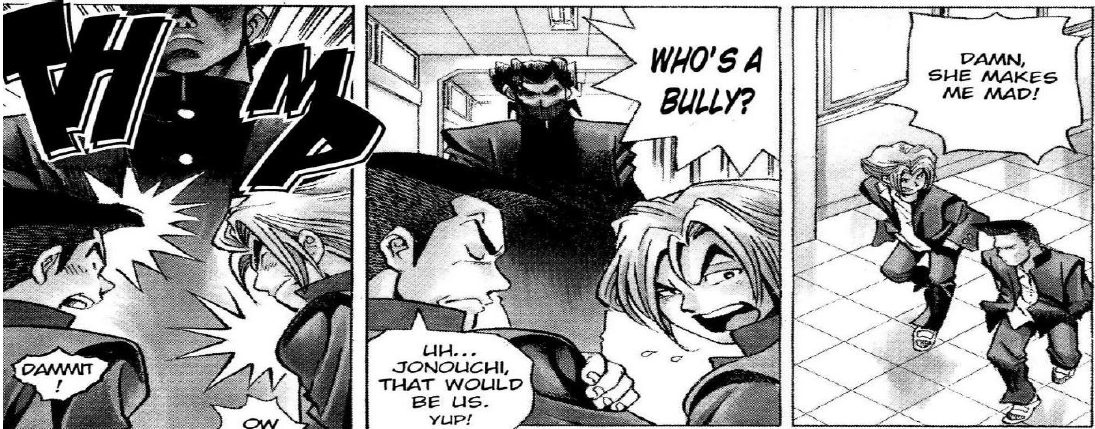
Later, Ushio tracks down Yugi and promises him that he’ll be his bodyguard. When Yugi gets home to what’s also his grandpa’s game shop, he finds Anzu who wants to hang out. We also learn a little bit of insight on the millennium puzzle from Yugi’s grandpa. The next day, Ushio takes Yugi to the back of the school to show him something. What it turns out to be was Jonouchi and Honda’s beaten bodies. Yugi, horrified at the sight begged Ushio to attack him instead, which he gladly did, shocking Jonouchi who had just been called a friend by Yugi. After that, Ushio threatens Yugi to pay the bodyguard fee of 200,000 yen the next day, or else he’d give even more harm, taking out a knife that he licks.
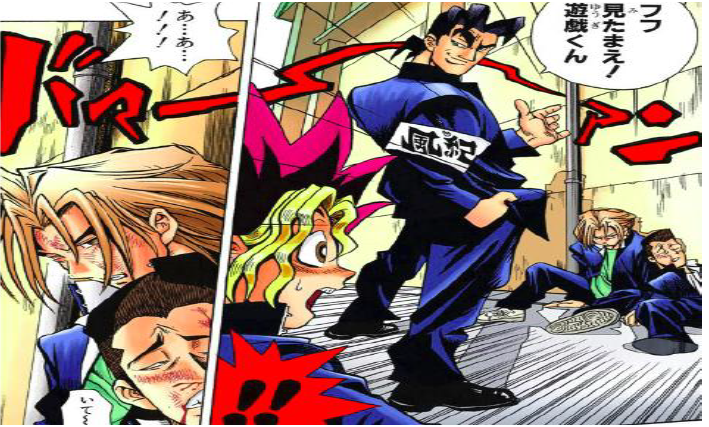
When Yugi gets home, despite his situation, all he does is solve the millennium puzzle. When he gets to the last piece, which is very impressive for something hasn’t been solved by him for 8 years, he notices the last piece is missing and begins to freak out. Instantly, Yugi’s grandpa gives him the piece, commenting that a man named Jonouchi had delivered it and he had been soaking wet. Right when Yugi solves the millennium puzzle, he becomes possessed by the spirit of an Ancient Egyptian Pharoh. This Pharoh calls out Ushio at night to
challenge him to a game called a shadow game. He explains that he’s brought double the amount of money Ushio wanted, but that it would be boring to just hand it over so he wants to play a game first. The game is about who can stab the most amount of money in their hand without hurting their hand, and they use Ushio’s knife. Getting to the point where Ushio becomes impatient, he breaks the rules and throws the knife at Yugi. Due to breaking the rules, Yugi gives him a punishment game, which is pretty much a mental disability, where he can’t see anything but money. The next day he’s caught playing with leaves thinking they’re money. After this whole episode, Yugi and Jonouchi become friends.
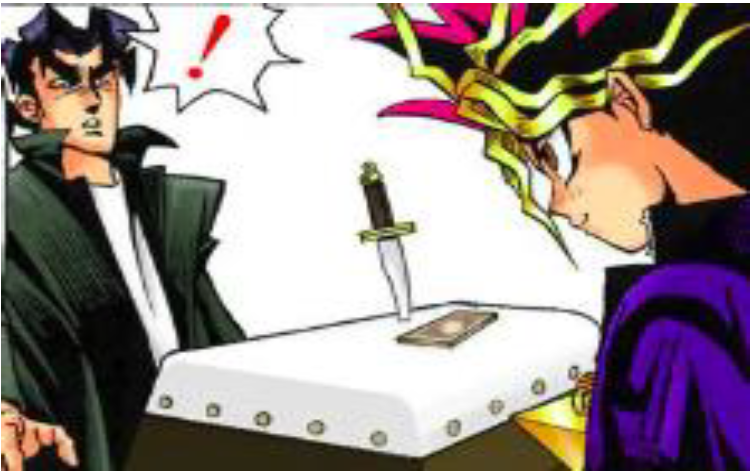
In the Toei anime where this all happens in the first episode, things are slightly different. When Yugi notices his millennium puzzle piece is missing, he goes to school looking for it, and then bumps into Ushio again who beats him up for not having the money. Jonouchi and Honda catch him, and after Jonouchi puts the missing piece in Yugi’s hand, which he had just fetched from the river, he and Honda attempt to attack Ushio, but get utterly defeated. Yugi with the last piece completes the Puzzle and begins the shadow game right at his location.
The shadow game in this version is changed so that it’s where Yugi and Ushio hang on a wall separated by a line of cards. The game is played by having the players taking turns flipping cards. The number on the card represents how high you can climb, and the winner of the game is the one who reaches the top first. Ultimately Ushio decides to cheat and climbs without flipping a card. The penalty game he gets in this version is where he envisions himself falling into the water and being eaten alive by a serpent. In the Duel Monsters! Anime this entire event is only featured in an anime only flashback during the duelist kingdom arc in episode 3. Yugi and Jonouchi basically remember how they became friends and flash to when Yugi stood up against Ushio for Jonouchi who was being bullied by him, even though Jonouchi had once bullied Yugi. No reference beyond that.
 Far left is Ushio’s manga design. Middle is his design in the Toei anime. Far right is his design in the Duel Monsters! Anime.
Far left is Ushio’s manga design. Middle is his design in the Toei anime. Far right is his design in the Duel Monsters! Anime.Most of the first 7 volumes of the manga has to do with Yugi punishing people who mess with him and his friends, while being possessed. Of course though in many occasions you have to admit he takes things too far. To the point he has in fact straight out killed people in the manga. When a criminal uses Anzu as a hostage, Yugi gets Russian Vodka poured all over him and gets the man to burn himself to death. Also, when a school bully simply ruins a bunch of carnival games, you know what his punishment was as decreed from the Pharoh. Death. And not just any type of death, but a death from being blasted by nitroglycerin.
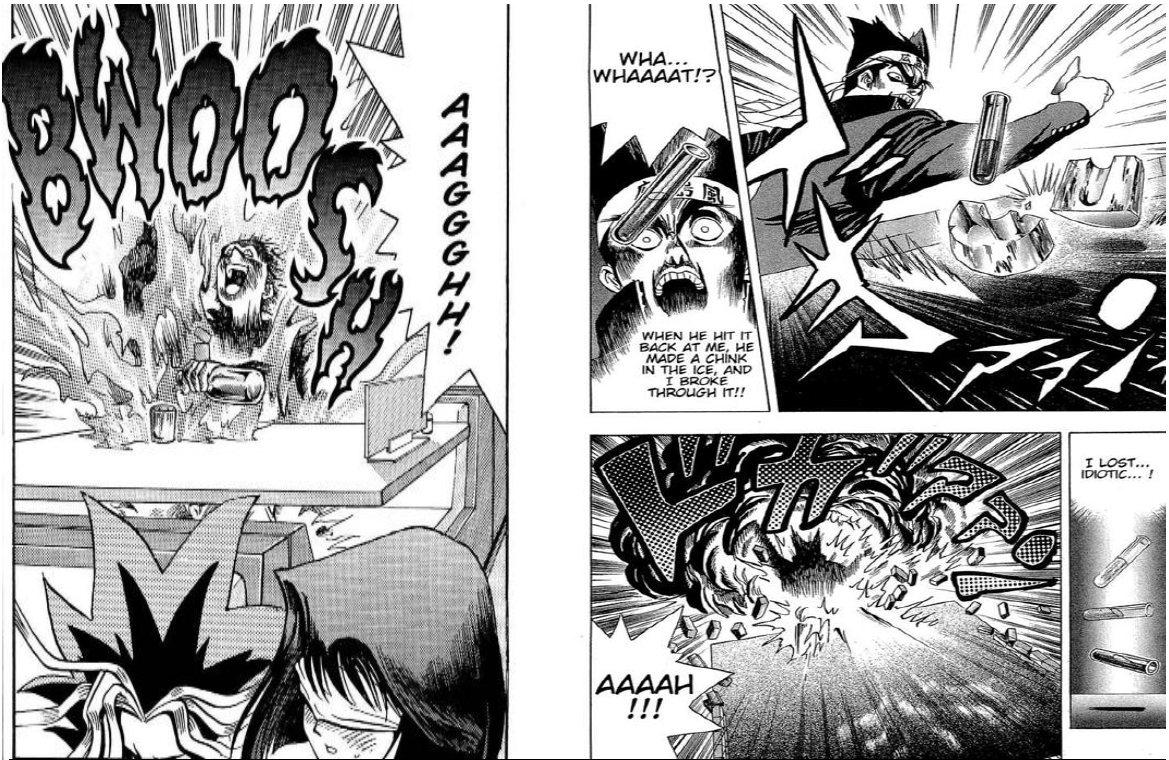 So Yugi has basically committed first degree murder twice. Well great!
So Yugi has basically committed first degree murder twice. Well great!Next time we’ll take a look at the introduction of the first major plot dependent character, Kaiba, and the intro to everyone’s favorite children’s trading card game. (Oh and by the way, speaking of censorship, the real life Yu-Gi- Oh! card game has censored artwork in Korea and every country outside of Asia.) Then we’ll look at the introduction to Shadi. After that we’ll examine the Death T arc, where Kaiba wants revenge, then the monster world arc where Bakura and his dark personality hidden in the millennium ring are introduced, and then move on to the arcs most fans are familiar with in order, starting with the Duelist Kingdom arc.




